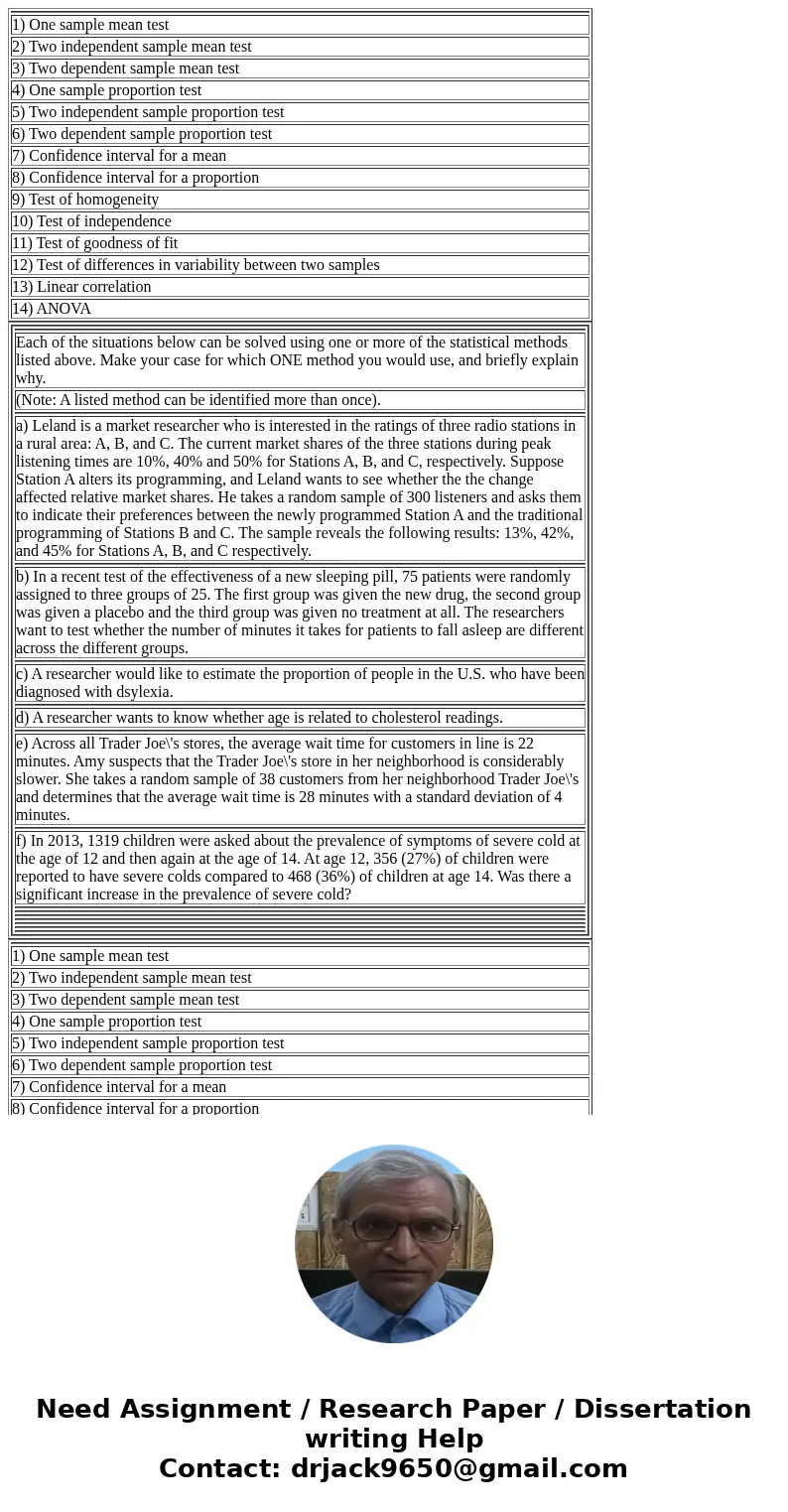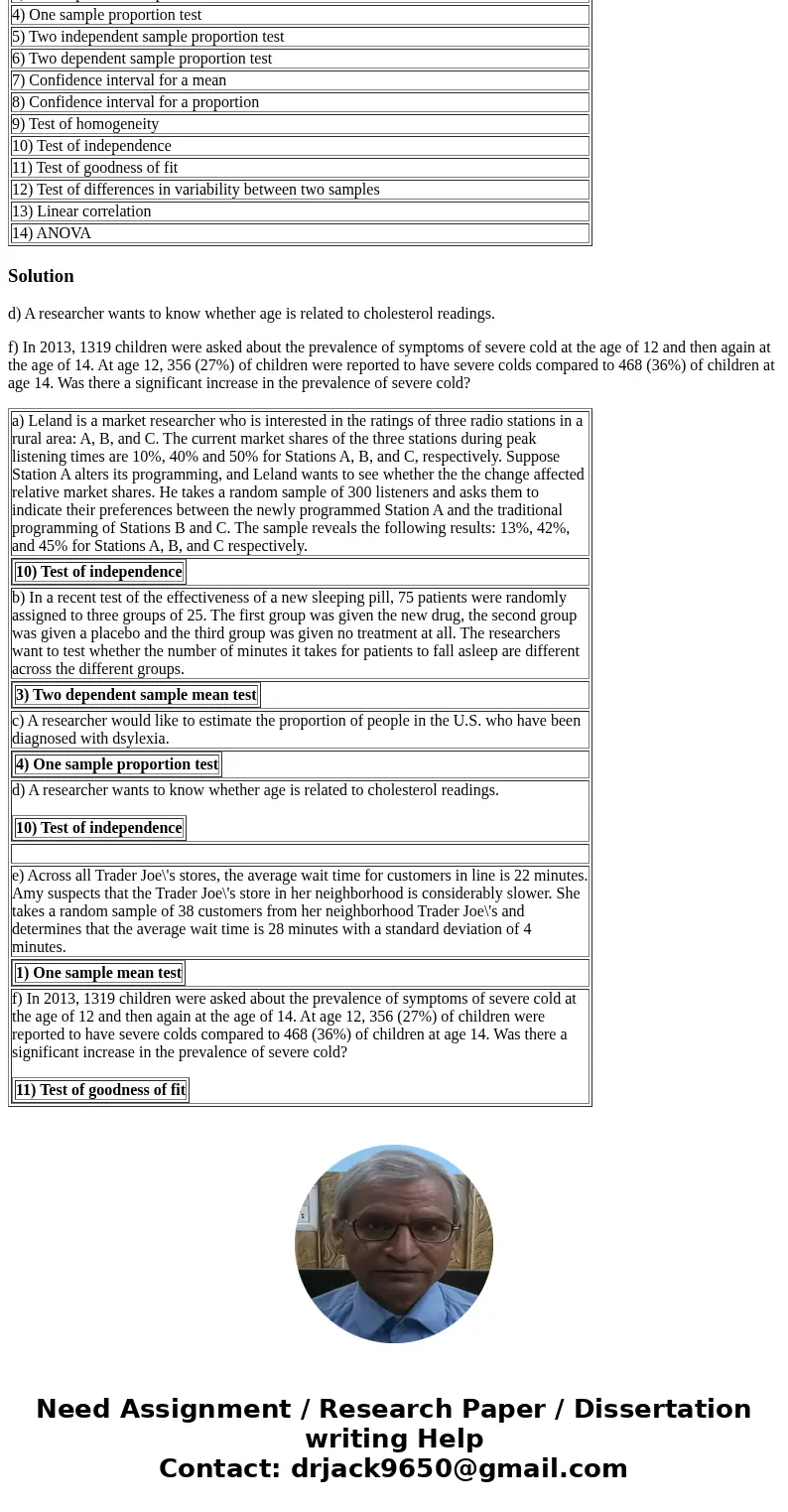|
| 1) One sample mean test |
| 2) Two independent sample mean test |
| 3) Two dependent sample mean test |
| 4) One sample proportion test |
| 5) Two independent sample proportion test |
| 6) Two dependent sample proportion test |
| 7) Confidence interval for a mean |
| 8) Confidence interval for a proportion |
| 9) Test of homogeneity |
| 10) Test of independence |
| 11) Test of goodness of fit |
| 12) Test of differences in variability between two samples |
| 13) Linear correlation |
| 14) ANOVA |
| | Each of the situations below can be solved using one or more of the statistical methods listed above. Make your case for which ONE method you would use, and briefly explain why. | | (Note: A listed method can be identified more than once). | | | a) Leland is a market researcher who is interested in the ratings of three radio stations in a rural area: A, B, and C. The current market shares of the three stations during peak listening times are 10%, 40% and 50% for Stations A, B, and C, respectively. Suppose Station A alters its programming, and Leland wants to see whether the the change affected relative market shares. He takes a random sample of 300 listeners and asks them to indicate their preferences between the newly programmed Station A and the traditional programming of Stations B and C. The sample reveals the following results: 13%, 42%, and 45% for Stations A, B, and C respectively. | | | b) In a recent test of the effectiveness of a new sleeping pill, 75 patients were randomly assigned to three groups of 25. The first group was given the new drug, the second group was given a placebo and the third group was given no treatment at all. The researchers want to test whether the number of minutes it takes for patients to fall asleep are different across the different groups. | | | c) A researcher would like to estimate the proportion of people in the U.S. who have been diagnosed with dsylexia. | | | d) A researcher wants to know whether age is related to cholesterol readings. | | | e) Across all Trader Joe\'s stores, the average wait time for customers in line is 22 minutes. Amy suspects that the Trader Joe\'s store in her neighborhood is considerably slower. She takes a random sample of 38 customers from her neighborhood Trader Joe\'s and determines that the average wait time is 28 minutes with a standard deviation of 4 minutes. | | | f) In 2013, 1319 children were asked about the prevalence of symptoms of severe cold at the age of 12 and then again at the age of 14. At age 12, 356 (27%) of children were reported to have severe colds compared to 468 (36%) of children at age 14. Was there a significant increase in the prevalence of severe cold? | | | | | | | | |
|
| 1) One sample mean test |
| 2) Two independent sample mean test |
| 3) Two dependent sample mean test |
| 4) One sample proportion test |
| 5) Two independent sample proportion test |
| 6) Two dependent sample proportion test |
| 7) Confidence interval for a mean |
| 8) Confidence interval for a proportion |
| 9) Test of homogeneity |
| 10) Test of independence |
| 11) Test of goodness of fit |
| 12) Test of differences in variability between two samples |
| 13) Linear correlation |
| 14) ANOVA |
d) A researcher wants to know whether age is related to cholesterol readings.
f) In 2013, 1319 children were asked about the prevalence of symptoms of severe cold at the age of 12 and then again at the age of 14. At age 12, 356 (27%) of children were reported to have severe colds compared to 468 (36%) of children at age 14. Was there a significant increase in the prevalence of severe cold?
| a) Leland is a market researcher who is interested in the ratings of three radio stations in a rural area: A, B, and C. The current market shares of the three stations during peak listening times are 10%, 40% and 50% for Stations A, B, and C, respectively. Suppose Station A alters its programming, and Leland wants to see whether the the change affected relative market shares. He takes a random sample of 300 listeners and asks them to indicate their preferences between the newly programmed Station A and the traditional programming of Stations B and C. The sample reveals the following results: 13%, 42%, and 45% for Stations A, B, and C respectively. |
| |
| b) In a recent test of the effectiveness of a new sleeping pill, 75 patients were randomly assigned to three groups of 25. The first group was given the new drug, the second group was given a placebo and the third group was given no treatment at all. The researchers want to test whether the number of minutes it takes for patients to fall asleep are different across the different groups. |
| 3) Two dependent sample mean test | |
| c) A researcher would like to estimate the proportion of people in the U.S. who have been diagnosed with dsylexia. |
| 4) One sample proportion test | |
| d) A researcher wants to know whether age is related to cholesterol readings. |
|
| e) Across all Trader Joe\'s stores, the average wait time for customers in line is 22 minutes. Amy suspects that the Trader Joe\'s store in her neighborhood is considerably slower. She takes a random sample of 38 customers from her neighborhood Trader Joe\'s and determines that the average wait time is 28 minutes with a standard deviation of 4 minutes. |
| |
| f) In 2013, 1319 children were asked about the prevalence of symptoms of severe cold at the age of 12 and then again at the age of 14. At age 12, 356 (27%) of children were reported to have severe colds compared to 468 (36%) of children at age 14. Was there a significant increase in the prevalence of severe cold? | 11) Test of goodness of fit | |


 Homework Sourse
Homework Sourse